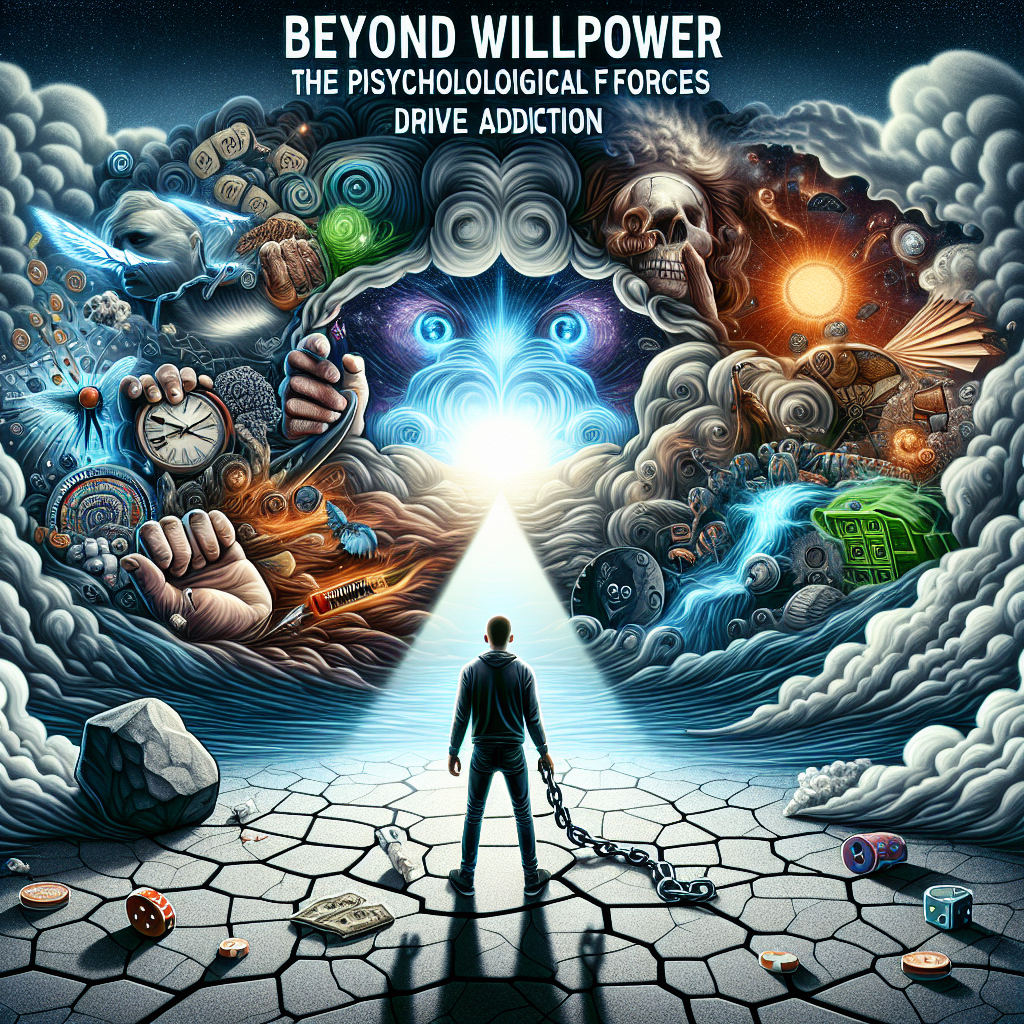
Beyond Willpower: The Psychological Forces That Drive Addiction
Introduction
Addiction remains one of the most complex and misunderstood phenomena in modern society. While many people view addiction solely through the lens of willpower—completely ignoring the psychological underpinnings at play—this perspective is not only simplistic but potentially harmful. In Beyond Willpower: The Psychological Forces That Drive Addiction, we will delve into the intricate web of psychological factors that drive individuals to addiction. This exploration goes beyond just understanding addiction itself; it aims to highlight the paths to recovery that are often overshadowed by conventional wisdom.
What drives a person to seek comfort in substances or destructive behaviors? Can an understanding of these underlying factors lead to more effective recovery methods? This article will tackle these critical questions, using real-world case studies to provide insights into the multifaceted nature of addiction.
The Myth of Willpower: Understanding Addiction
Willpower vs. Psychological Forces
Addiction is far more nuanced than simply lacking willpower. The belief that individuals can overcome their addictions solely by exercising self-control fails to acknowledge a plethora of psychological, environmental, and biological influences. These factors can create conditions that foster dependency, often beyond an individual’s conscious control.
The Brain’s Reward System
Understanding addiction begins with knowing how the brain’s reward system functions. The neurotransmitter dopamine plays a significant role in feelings of pleasure and reinforcement. When an individual engages in addictive behavior—be it substance use, gambling, or compulsive eating—dopamine levels spike, reinforcing that behavior.
Table 1: Brain Regions Involved in Addiction
| Brain Region | Role in Addiction |
|---|---|
| Nucleus Accumbens | Key player in the reward pathway; releases dopamine |
| Prefrontal Cortex | Governs decision-making and self-control |
| Amygdala | Processes emotions, impacting cravings and triggers |
| Hippocampus | Involved in memory formation, linking past experiences to cravings |
Case Study: The Opioid Epidemic
The opioid crisis in the United States starkly illustrates the concept of addiction beyond willpower. Many individuals addicted to prescription medications began their journey with a legitimate need for pain management. Emotional factors such as trauma, chronic stress, and mental health conditions often exacerbate the transition from use to dependency.
Analysis
Through the lens of Beyond Willpower: The Psychological Forces That Drive Addiction, we can see that opioid addiction is not merely a failure to resist temptation, but rather a complex interaction of psychological distress, biological vulnerability, and environmental factors. Effective treatment needs to address these underlying issues rather than merely enforcing willpower.
Environmental Influences on Addiction
The Role of Stress and Trauma
Environmental factors play a crucial role in addiction. High-stress environments, often marked by socio-economic challenges, traumatic experiences, and family history, can lead to increased susceptibility. These stressors can trigger maladaptive coping mechanisms, such as substance use.
Case Study: Childhood Trauma and Addiction
Research shows that individuals who experience significant childhood adversity are at a higher risk for developing various forms of addiction. For instance, a study found that children who faced emotional abuse were more likely to turn to drugs or alcohol in adulthood as a means of coping.
Analysis
This case highlights the necessity of addressing emotional wounds in therapeutic settings. Recognizing that addiction often stems from unaddressed trauma paves the way for more compassionate treatment models focused on healing rather than judgment.
Psychological Mechanisms Behind Addiction
The Role of Conditioning and Reinforcement
Behavioral psychology teaches us that addiction can often be traced back to learned behaviors. Positive reinforcement—experiencing pleasure or relief from using a substance—teaches the brain to associate that behavior with reward, cementing its role in the addicted person’s life.
Case Study: Gambling Addiction
Gambling addiction exemplifies this phenomenon. Many individuals begin gambling as a social activity but may find themselves drawn deeper into the cycle of gambling to recreate the ‘high’ from previous wins.
Chart 1: Reinforcement Cycle in Gambling Addiction
| Stage | Description |
|---|---|
| Initial Engagement | Positive social experience |
| Early Wins | Increased dopamine release |
| Losses | Attempt to recapture previous high |
| Escalating Behavior | Increased frequency and stakes |
Conclusion
Recognizing the reinforcement cycles present in addiction can guide interventions designed to break this cycle. The insight that addiction can be conditioned through rewards challenges the stereotype that addiction is simply a moral failing.
Emotional Regulation and Addiction
The Psychological Vulnerability Hypothesis
Many researchers posit that addiction often serves as a maladaptive mean for emotional regulation. Individuals may use substances or engage in compulsive behaviors to manage emotional pain, anxiety, or stress. Here, addiction becomes a coping mechanism rather than a lifestyle choice.
Case Study: Alcohol Use in Managing Anxiety
Individuals suffering from anxiety disorders may find temporary relief in alcohol consumption. The initial calming effect can lead to a cycle of dependency, as the individual increasingly relies on alcohol to navigate anxiety.
Analysis
This case underscores the importance of treating underlying mental health issues as part of recovery programs. Merely addressing substance use without acknowledging emotional undercurrents fails to dismantle the addiction’s hold on a person.
Social Dynamics of Addiction
Peer Pressure and Social Identity
Another influential factor in addiction is the social context. Peer pressure, social acceptance, and even cultural norms can push individuals toward substance use. For many, identity and belonging play significant roles; addiction can offer a sense of community, even if it’s toxic.
Case Study: College Student Substance Use
Among college students, patterns of binge drinking or drug use are frequently seen as rites of passage. The urge to fit in or be accepted can trigger substance use, creating a cycle where addiction thrives among vulnerable populations.
Analysis
Understanding social influences highlights the need for community-based interventions that focus on fostering healthy social interactions rather than solely treating the addiction. Beyond Willpower: The Psychological Forces That Drive Addiction emphasizes the importance of community and belonging in fostering resilience.
Pathways to Recovery
Integrative Approaches to Treatment
Understanding that addiction is driven by psychological forces opens the door to innovative treatment methodologies. Recovery programs that incorporate mental health therapy, emotional skills training, and community support appear to be more effective in addressing the root causes of addiction.
Types of Therapy
- Cognitive Behavioral Therapy (CBT): Helps individuals recognize and alter harmful thought patterns.
- Motivational Interviewing: Encourages self-efficacy and personal motivation.
- Trauma-Informed Care: Addresses past trauma as a key factor in addiction.
Case Study: A Comprehensive Recovery Program
Programs that integrate therapy, peer support, and community engagement have shown promise in long-term recovery outcomes. For example, a program combining CBT with sober living environments demonstrated a reduction in relapse rates, highlighting the value of addressing both psychological and physical aspects of addiction.
Conclusion
As we reflect on the insights gleaned from Beyond Willpower: The Psychological Forces That Drive Addiction, it becomes clear that addiction is not simply a battle of wills. Factors such as environmental influences, psychological conditioning, emotional regulation, and social dynamics all coalesce to shape an individual’s relationship with addiction.
Moving forward, emphasizing a comprehensive understanding of these forces can help reshape treatment and recovery programs, fostering a more compassionate, effective approach to healing. We encourage readers to grasp the complexity of addiction and advocate for a holistic approach that sees beyond mere willpower.
FAQs
What are the main psychological forces behind addiction?
- Key forces include emotional regulation struggles, trauma, learned behaviors, and social dynamics.
Can addiction be treated without focusing on willpower?
- Yes, effective treatments consider emotional, social, and psychological factors rather than relying solely on an individual’s willpower.
How does the environment influence addiction?
- Stressful environments can exacerbate vulnerabilities, triggering maladaptive coping mechanisms that lead to addictive behaviors.
Why is trauma-informed care essential in treating addiction?
- Trauma-informed care acknowledges the role of past trauma in addiction and aims to address these underlying issues in a supportive manner.
- What role does community play in recovery from addiction?
- Community support fosters belonging, accountability, and resilience, which are crucial for long-term recovery outcomes.
By exploring the intricacies of addiction through the lens of psychological forces, we move closer to unraveling the complexities surrounding it and paving a more compassionate path toward recovery.













